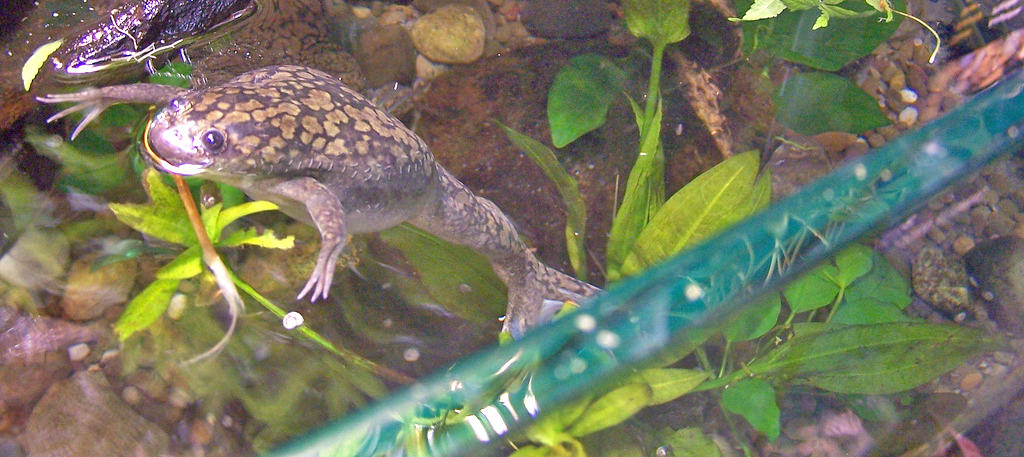Share this article
YouTube videos reveal why some amphibians become invasive
YouTube videos that people upload of their amphibian pets are helping researchers understand what types of frogs and salamanders may become invasive.
“The same traits that make some species successful invaders are very similar to the traits that make them successful pets,” said John Measey, a biology professor at Stellenbosch University in South Africa and the lead author of a study published recently in Frontiers in Ecology and Evolution. “You can breed them easily, and they survive in very poor conditions.”
Invasive amphibians are a huge problem in North American and throughout the world. Alien species — whether invasives from other continents, like the African clawed frog (Xenopus laevis), a cannibalistic amphibian invasive in Florida, California and Mexico, or domestic species like the American bullfrog (Lithobates catesbeianus), which is expanding its traditional eastern territory westwards on the continent — can outcompete other species due to size and aggressiveness. They can also be vectors for disease like the deadly chytrid fungus or the salamander-killing Batrachochytrium salamandrivorans (Bsal), or cause problems for native predators such as the venomous cane toad (Rhinella marina) in Hawaii or Australia.
Many of these amphibians enter new environments when they escape their aquariums, or when unwitting pet owners release them into the wild. Measey and his co-authors wanted to understand exactly what made these invasive species popular among pet owners in the first place in an effort to curtail some of the bigger threats.
“It has often puzzled me,” Measey said. “It’s not entirely obvious why someone wants to have a frog sitting in an aquarium in their living room.”
He and his co-authors watched 847 videos uploaded on freely accessible platforms like YouTube. They recorded 173 captive species in the videos and found the most popular activity people filmed involved the amphibians eating—a surprise to Measey, who assumed that breeding activity would be the most popular due to the large variety of breeding behaviors used by amphibian species.
From YouTube videos, Measey said that managers could tell whether invasive species are popular in the pet trade — information that could inform decisions to ban the trade in particularly dangerous cases.
They could also look at the types of traits that make amphibians better feeders, allowing managers to home in on potential invaders. Species with bigger mouths, for example, which eat larger prey items, may be particularly popular in the pet trade. Amphibians that fit this bill and carry a high danger of becoming invasive could be monitored or regulated in the pet trade, he said, even if they are not currently sold as pets.
“We might be able to flag those as being things that shouldn’t be traded even though the market may move in that direction,” Measey said.
A few particularly dangerous invasives like African clawed frogs and tiger salamanders (Ambystoma tigrinum) were involved in a disproportionate number of videos. But Measey said that videos featuring these animals were still less than those involving non-invasive native species like American toads (Anaxyrus americanus). While the high number of native species may seem like good news, Measey also said that the researchers observed a number of inappropriate or cruel videos posted on video platforms involving American toads likely taken from the wild.
These included kids putting toads in Lego cars and driving them around, and tying frogs to helium balloons and letting them fly off — a vector for invasion perhaps unconsidered by wildlife managers. One even showed a chef in China preparing a critically endangered giant salamander for consumption in a restaurant. Fortunately, Measey said, threatened species were underrepresented in the videos the team observed.
While it’s quite common for people, especially kids, to capture frogs and bring them home, Measey said, this behavior can also be harmful to populations at large, since individuals kept in captivity have higher stress levels that can make them more susceptible to disease. When these individuals are released, they can infect healthier individuals and populations with pathogens like the chytrid fungi.
Measey said this kind of study could also be used to track the success of wildlife management measures such as the U.S. and Canada’s decision to ban the import of pet salamanders in face of the deadly fungal Bsal threat.
View two of the videos that the researchers analyzed below.
Header Image: Researchers analyzed dozens of YouTube videos to find out why people liked keeping species that pose an invasive threat, such as this African clawed frog. ©Jeff Egnaczyk








